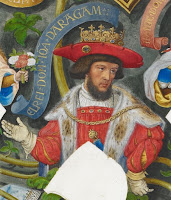King John I of Castile died in October 1390, however, and was succeeded by his son Henry. Eleanor disapproved of her nephew, and with some allies formed the League of Lillo to depose him. Her plan failed, and Henry forced her to return to Navarre and King Carlos in February 1395.
Things changed: she became involved in Navarre politics, and the relationship with Carlos improved. They had two sons, Charles and Louis, both of whom died young (Charles at the age of five, Louis before he was one). Their oldest daughter, Joan (1382 - 1413), was groomed as Carlos' heir to the throne.
Although the two were married when Carlos' father died and he became king, Eleanor had never been crowned officially. Her coronation finally took place on 3 June 1403 in Pamplona (the week prior to Carlos trying to make the illegitimate Lanzarot the bishop of Pamplona). You can see her coat of arms above with her royal status represented.
Eleanor was entrusted to the kingdom as regent when Carlos was away, and she worked to keep good relations between Navarre and her home of Castile. When Carlos and Eleanor both traveled, Joan was left as regent. Joan died in 1413, and the succession was settled on their third daughter, Blanche. (A second daughter, Maria, had died in 1406 at the age of 22, unmarried).
The date of Eleanor's death is debated, but by March of 1416 she had died and was interred in the Cathedral of Santa Maria la Real in Pamplona. Carlos died in 1425 at the age of 64 and was interred with her.
That leaves Blanche I, Queen of Navarre as of 8 September 1425, who married someone I have said a lot about just a couple months ago. We'll pick up her story tomorrow.




